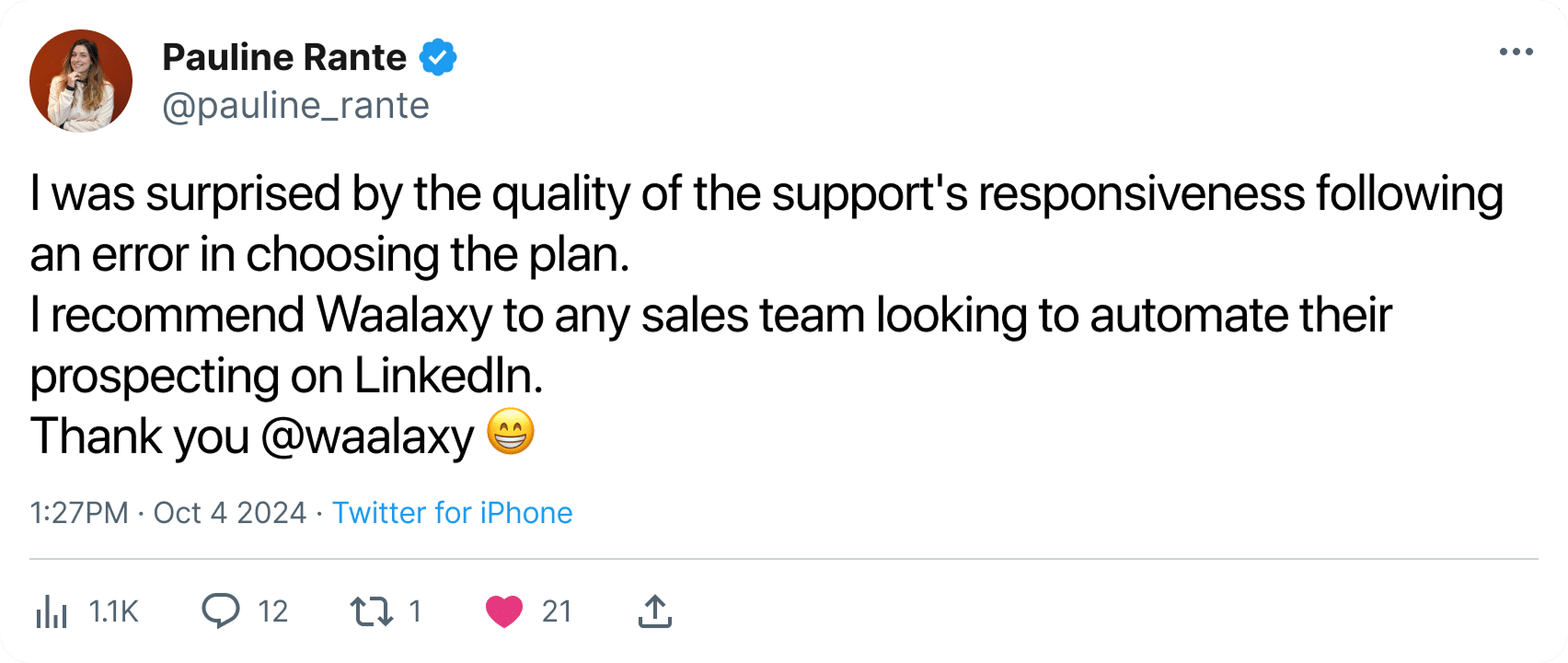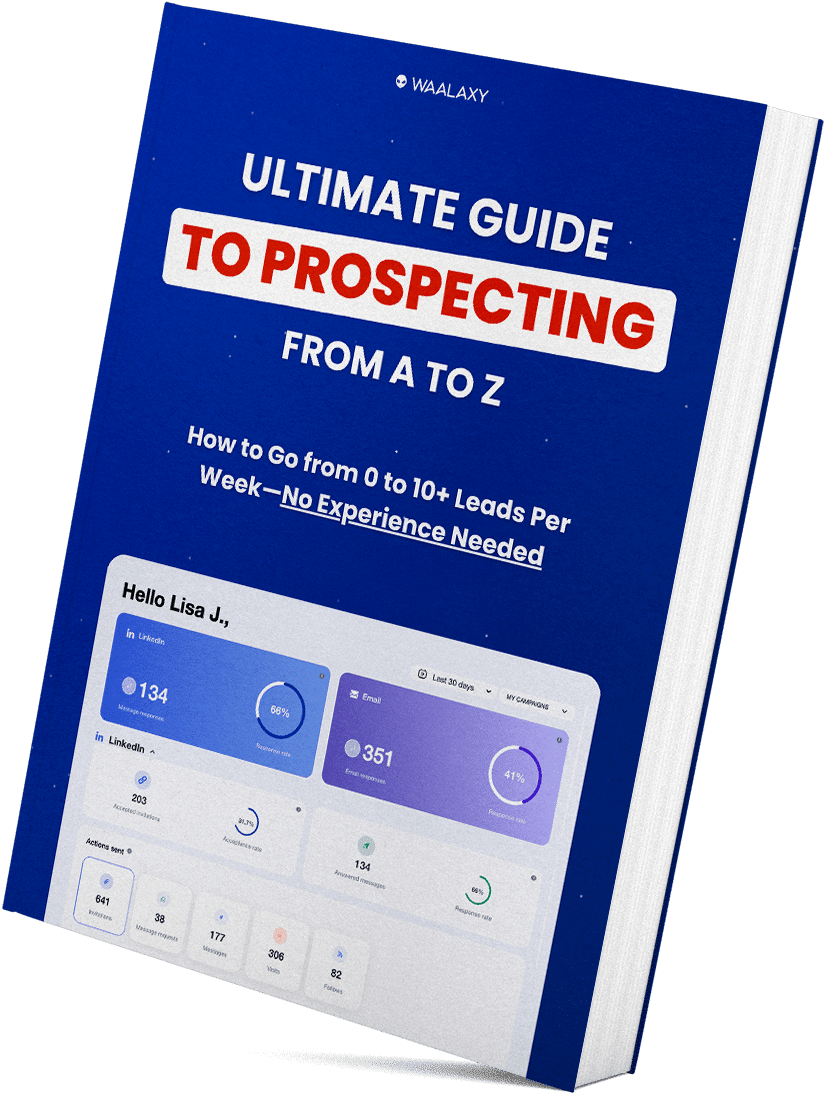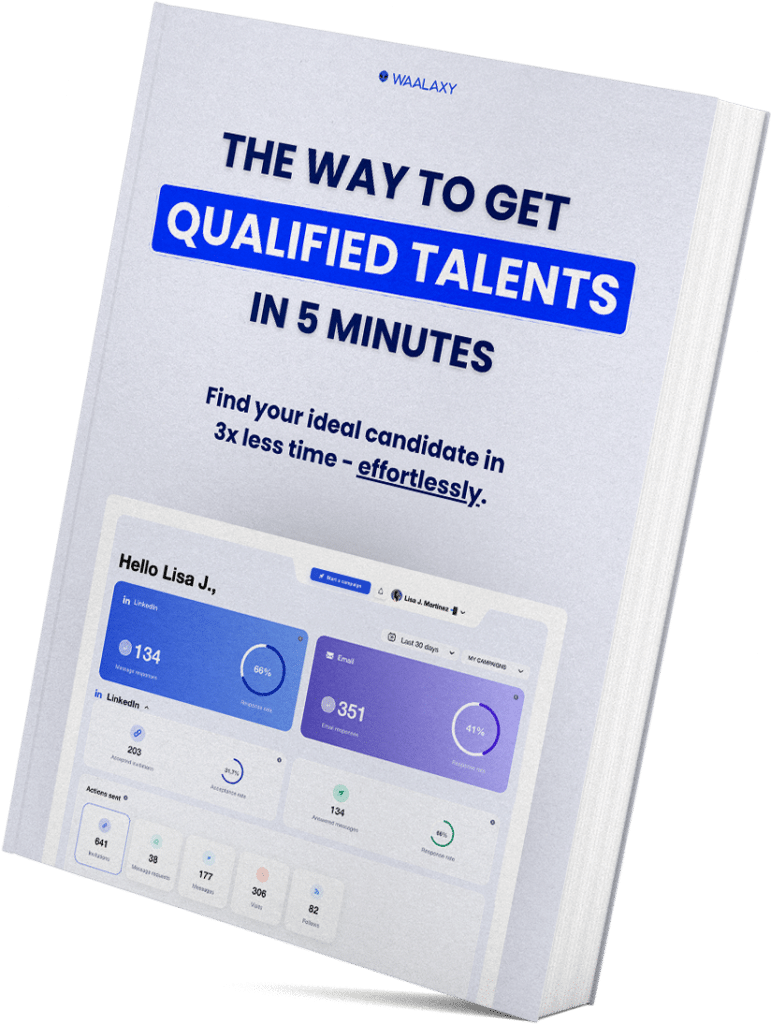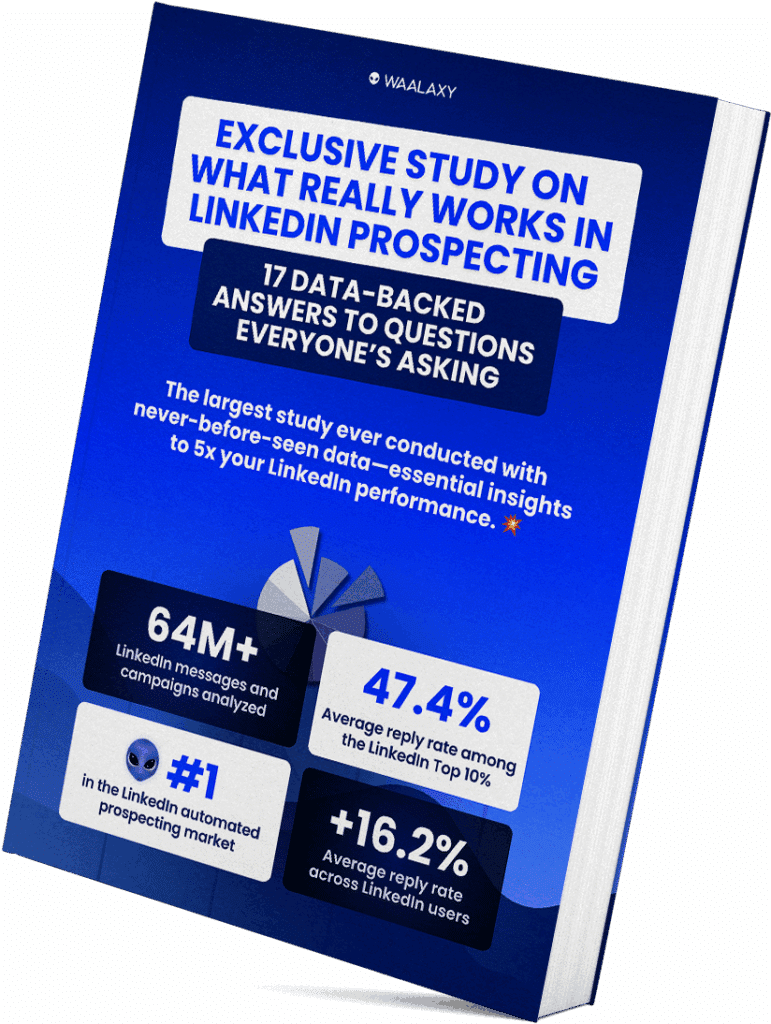What’s the difference between a prospecting email that works and a prospecting email that flops? 🤔 The email content, obviously.
You know this, and you’re looking for the best cold email templates B2B? You’ve come to the right place, we’ve collected +25 templates to share with you! 🔥
But that’s not all! ➡️ On the program:
- Defining a prospecting message.
- +25 best cold email templates B2B to prospecting.
- The ultimate method for writing a good prospecting email template.
- Contact thousands of prospects easily by email with automation.
Let’s get started! ⚡
What is a prospecting message?
📩 A commercial prospecting message (or prospecting mailing) is a targeted communication sent to a prospect with the aim of :
- Establish an initial contact/connection.
- Generate commitment.
- Build a relationship.
- Identify needs.
- Generate interest in a product, service or collaboration.
It’s usually short, direct and personalized to meet the prospect’s specific needs or issues.
👉🏼 To be effective, a prospecting email template message must contain a powerful hook, a clear value proposition and a call to action to encourage the recipient to respond or start a discussion.
A prospecting message can be delivered via different channels: telephone, LinkedIn, or even email (it’s on channel that we focus in this article).
The prospecting email is a type of email marketing (as well as newsletters, promotional campaigns, transactional emails), frequently used in B2B email prospecting strategies.
📋 To send them, you’ll need to have an email list containing the professional addresses of your prospects (already interested in your offer), or collect the e-mail addresses of “unknown persons” corresponding to your target (with no prior interest or request) to contact them.
Then comes the dreaded moment 😰 when you have to write your cold email and prospecting email template to get responses and results. Here are +25 best cold email templates B2B to inspire you.
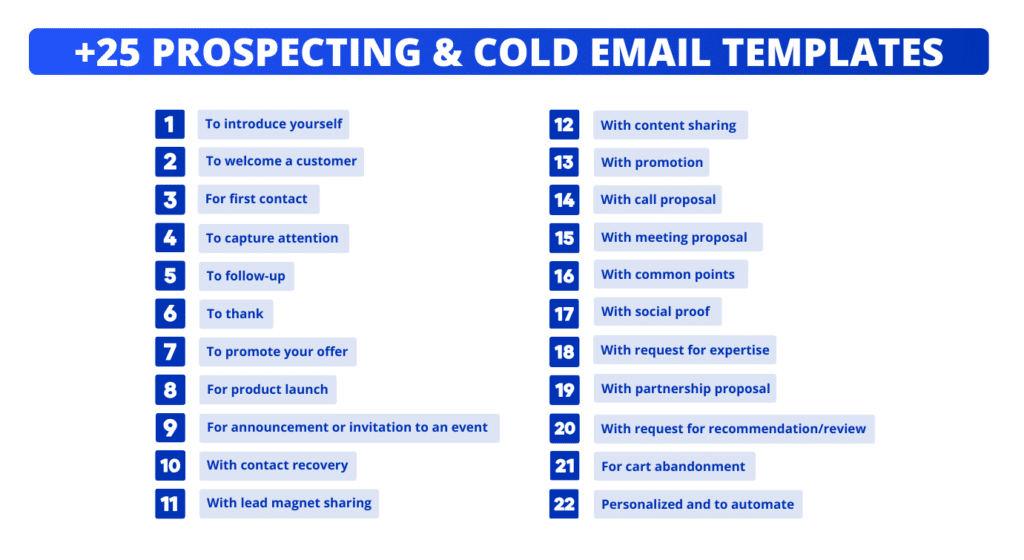
+25 Best cold email templates B2B to prospecting
There are a number of ways you can use prospecting email template to successfully approach and improve your sales. We’ll let you choose the one that suits you best! 😇
Of course, you’ll need to tailor your prospecting email template message to the solution you have to offer on the market.
1. Cold email template B2B to introduce yourself
To introduce yourself and/or get in touch with your prospects for the first time, you can use this type of cold outreach email. 👇🏼
Subject line: interested in a new relationship 🙂
Hi {{FirstName}},
I’m [Your First Name], I work at [Company Name], where we help [target sector/activity] with [general outcome or common interest]. I noticed that you’re in [specific sector/activity] and thought it would be nice to chat.
No big sales pitch here, just a desire to chat, share ideas and see if we can learn from each other.
What do you say? See you soon,
[Professional email signature]
2. Welcome cold email template B2B
When a prospect registers or makes a purchase, don’t hesitate to send them a short welcome message.
Subject line: Welcome to the adventure 🤗
Hi {{FirstName}},
Thank you again for your trust and welcome to [Company Name]! We’re super happy to welcome you and count you among the users of our [product/service], and we hope you like it already.
🎉 If you have any questions, ideas to suggest or just feel like chatting, I’m here. You can also write to us on social networks and at [Company email address].
We love to get feedback so we can improve and better support you.
See you soon,
[Professional signature]
Depending on your product or service, use humor and make your potential customers want to stay loyal to your solution. 🌟
3. 1st contact cold email template B2B
The main purpose of your email is to get to know the prospect’s plans and create a link to let them come to you, before proposing a solution 😉
Subject line: Congratulations on your new role!👏🏼
Hello {{FirstName}},
I noticed that you recently took on your new role at {{CompanyName}}, congratulations on this great step! 🎉
I was wondering: have you already thought about the priorities you want to set for your teams?
I love to chat about these kinds of topics, so if you’d like to discuss this opportunity, I’m here. I look forward to hearing from you!
See you soon,
[Professional signature]
4. Attention-grabbing cold email template B2B
Turn the problem into a riddle or a question to arouse your contact’s curiosity. 👀 If you succeed, he’ll respond. And, the more he talks to you, the more he engages with you.
Subject line: What if you could save an hour a day?⏰
Hello {{FirstName}},
In your opinion, how many qualified leads per week can you contact effortlessly, in less than 10 min/day and for €0/month? Find out the answer here: [Link].
At Waalaxy, we love this kind of challenge: simplifying your daily life by freeing up time for what really matters.
If this sounds like something you’d like to do, I’d be delighted to discuss it with you.
See you soon,
[Professional Signature]
This type of format works well for emails as well as LinkedIn messages. 👤
5. Follow-up cold email template B2B
Here’s an example ready to use of follow-up email copy and paste ✨ :
Subject line: Are you still interested? 🤔
Hello {{FirstName}},
I was wondering if you’d had time to think since our previous exchange, so I’ll allow myself a brief reminder. Do you need further information?
If you’re available this week, you can book an appointment in my diary [Link], or please let me know what suits you, I’ll adapt.
I’d be delighted to talk to you about your needs or just share ideas!
See you soon,
[Professional signature]
✅ Here are some tips for adapting and formulating your own reminder mails:
- Use cold email with the same structure as for your first messages.
- Modify the teaser, value proposition and CTA if you’re relaunching.
- Avoid classic follow-up emails like “Did you see my previous message?”.
- Create a pattern break for the last follow-up e-mail: use familiarity or humor (as in the cold email template B2B below).
- No formalities: stay direct and to the pain point.
- Maximum 500 characters.
Subject line: Shall we talk or shall I sing to get your attention? 🎤
Hi {{FirstName}},
And yes, it’s me again!
So, here goes: would you rather we chat about [topic], or shall I whip up a karaoke performance for you for the next re-launch? 😄
Seriously, if you’ve got 10 minutes this week, please let me know when it’s convenient. Otherwise, I promise to work on my vocalizations!
See you soon,
[Professional signature]
6. Thank-you cold email template B2B
The thank-you e-mail is an important part of your marketing and cold email strategy. It shows your customers and partners that they’re important and part of your business. 👑
Subject line: Thank you for your time! 🙏
Hello {{Firstname}},
Many thanks for taking the time to [note name of action]. I really appreciated your interest in [topics, products or services covered]. I’m convinced there are lots of great things we could build together.
If you have any questions or ideas, please don’t hesitate to consult our very detailed FAQ or to share them with me – I’m always available to talk about them.
See you soon,
[Professional Signature]
7. Prospecting email template to promote your offer
Thanks to marketing segmentation, you can find out your prospects’ key information and hard-to-counter objections, then create ultra-personalized e-mails (like the prospecting email template below). 🎨
Subject line: How about simplifying your days with automation? 🦾
Hello {{FirstName}},
I’ve seen that you’re in marketing and that you regularly post on LinkedIn to develop your network and find new customers.
You probably have a thousand things to deal with every day. 🤯 What if I told you we could help you automate some of your prospecting?
At [Company name], we’ve designed a simple tool to contact up to 100 qualified prospects a week, in less than 10 min/day. The result: you save time, increase your visibility and focus on what really matters.
Are you interested? Test [Tool name] for 0€ [Link]. 🚀
See you soon,
[Professional signature]
In this e-mail: you explain the problem, you reply with the solution and the list of advantages, you also propose to discuss it… So it’s complete and perfect for tipping the balance in your favor.
⚠️ Please note that if you want to tell your prospects what they’re going to gain in quantitative terms, you need to make sure you have proof of what you’re saying.
8. Product launch cold email template B2B
Subject line: We’ve got something brand new for you ! 🤩
Hi {{FirstName}},
I wanted to share with you a little novelty that should please you: we’ve just launched [name of product/service], thought to [solve a problem or meet a specific need].
It’s brand new, and as you’re an expert on the subject, who works at {{CompanyName}} and is already a customer/subscriber of [Solution name], I’d like to let you try it out to get your opinion: [Access link].
If you have a few minutes to spare, I’d be delighted to hear what you think! Talk to you soon?
See you soon,
[Professional signature]
This personalized prospecting email template is very effective for :
- Gently introduce your product,
- Create a close relationship (by valuing their expertise and asking for their opinion).
- Increase the chances 🍀 that your prospects will test your new product/service (or talk about it around them).
9. Announcement/invitation to an event cold email template B2B
Writing a cold email template B2B to announce or invite to an event 📣 allows you to create an opportunity for dialogue with your prospects while offering them added value, such as insights, solutions or networking.
Subject line: Shall we meet soon?🚀
Hi {{FirstName}},
We’re holding [name of event], on [date], and I’d really like you to join us!
It’s the perfect opportunity to [event benefit, e.g. “discover our latest innovations”, “exchange with other professionals in your sector”,”cold email marketing trends of the year”, etc.].
It’s happening at [location or online], and I’m sure you’ll find plenty to inspire you. Are you coming? Click here to register: [Link].
If you have any questions, please don’t hesitate to contact us.
See you soon,
[Professional Signature]
Sending a cold email like this is commonplace, it’s a great way to announce what you’ll be doing for a particular event as well as engaging your audience in a more interactive and personal way. 🚀
10. Contact retrieval cold email template B2B
There are several ways to retrieve contacts to send them on of your B2B cold email template. 👇🏼
By an event or group
Sending a prospecting email template automatically to all contacts retrieved via groups, LinkedIn events or reactions to your LinkedIn posts (thanks to Waalaxy 👽), is ideal for exchanging ideas as well as finding out about the needs of people with similar interests to your own.
By competition
Sending a prospecting email template automatically to all your competitors’ users or contacts (thanks to Waalaxy), gives you access to a database of already-qualified prospects and enables you to capitalize on the differentiating features of your solution compared to the competition (and therefore save time). 😎
Subject line: What if we did even better? 🔥
Hi {{FirstName}},
I saw that you’re using [competitor product name], and that you’re looking for a new tool. What’s currently bothering you about [competing product name]?
I thought you might be interested in an alternative. At [Name of your company], we offer [your product], which allows you to [key advantage or differentiator, e.g.: “save even more time” or “simplify your daily management”].
I’m not here to knock [competitor’s name], but if you’re curious, I’d be delighted to talk to you about it. What do you think? 😊
See you soon,
[Professional signature]
11. Cold email template B2B with lead magnet sharing
Use this template if you know your contact is interested in your email content, and you want to maintain their interest / remind them of you by giving tips or sharing free content. 🤑
Subject line: A content thought for you ✨
Hi {{FirstName}},
Are you looking to [solve a problem or achieve a specific goal, e.g.“find customers on the internet” or “automate your prospecting”]?
I’ve got just the thing for you: our [name of the lead magnet, e.g. “complete guide to generating leads on LinkedIn”], a collection of our best tips. You can access it for free here: [Link].
Would you like to receive even more tips and content like this?
See you soon,
[Professional Signature]
It’s a win-win situation! 🏆 Here, we’re not selling a tool, but content that will keep the prospect in a“lead nurturing” sales process, i.e. we’ll continue to feed them high value-added content (until they become a customer).
12. Content sharing cold email template B2B
The aim of this prospecting email template is to drive the user to the 📲 site, so that :
- In a 1ᵉʳ time: they get further information, best practices or solutions there, to educate themselves and understand why they’re encountering such and such a problem.
- In a 2nd time: so they can learn about the added value of your offers.
Subject line: You might be interested!
Hello {{FirstName}},
I saw that you were interested in [relevant topic, e.g. “LinkedIn strategies” or “digital prospecting”] and that you downloaded our latest lead magnet on the subject [note title].
We hope it helped you find the answers you were looking for. We’ve just published an article on [specific topic], with practical advice and concrete examples.
Here’s the link: [Link]. Already +1000 people have read it (and given it a 5/5 ⭐). What do you think?
If you need to, you can find plenty of other articles on similar subjects, directly on our site: [Link].
See you soon,
[Professional signature]
ℹ️ In a second cold email template B2B, we may provide a solution to a specific problem (extract from the shared content).
13. Promotional cold email template B2B
Use this template to build and maintain customer loyalty by offering exclusive benefits! 💎
Subject line: A little surprise just for you 🎁
Hi {{FirstName}},
At [Company Name], we like to pamper our customers. That’s why we’re offering a special deal: -25% off our [product/service] with the code [CODEPROMO],
To take advantage of this offer, simply reply to this email, indicating “I’m interested”.
You’ll be able to discover [key product/service advantage] and try out everything we have to offer. But don’t delay, the offer is valid until [deadline] and on [add criteria].
So, what do you think? 😊 Don’t hesitate to ask for help or share your suggestions with our sales team via chat if need be.
Good day to you, [Your First Name]
[Professional signature]
By addressing the offer personally on special occasions (loyalty reward, birthday, Black Friday…), your prospects will feel even more appreciated and valued.
This message will reinforce loyalty and ultimately customer retention, towards your brand, product, company… 💒 By the way, thanks to them (we hope you get the ref).
And, we know that a satisfied customer will come back to buy and will even be likely to make recommendations and therefore, win you new customers. 🙌🏼
14. Call proposal cold email template B2B
📞 Proposing a cold call (another outbound marketing technique with e-mail) is always tricky. We advise you to wait until you’ve exchanged 2–3 messages with the prospect before proposing it.
Subject line: How about boosting your prospecting? 🎯
Hello {{FirstName}},
We’ve noticed that many business owners struggle to optimize their prospecting. The culprits are often :
– Lack of time to manage connections and messages,
– Difficulty in identifying relevant prospects,
– Lack of tools to automate these tasks.
How about a 10-minute chat to see how we can change that? I’ll share with you how +100,000 users saved time (and results) with simplified multichannel prospecting.
Any availability this week? 😊
See you soon,
[Professional signature]
15. Meeting proposal cold email template B2B
This B2B partnership email template is intended for freelancers, headhunters, recruiters or people wishing to propose professional partnerships. 🤝
Subject line: Shall we meet?
Hi {{FirstName}},
I wanted to suggest that we take a moment to meet. This would be an opportunity to discuss [theme or topic relevant to the recipient, e.g. “your current prospecting challenges” or “your goals for this year”].
Nothing formal, just a chat to see how we could share ideas or collaborate. Would you be available for a coffee or a call this week?
I look forward to meeting you and talking with you,
[Professional signature]
16. Common points cold email template B2B
Evoking commonalities is the easiest way to get your contact to identify with you, and therefore to create a bond with them (in business as in personal life). 🔗
Subject Line: Paris and [your domain] – we’ve got that in common!
Hi {{FirstName}},
I noticed that you also work in Paris as [profession/sector]. It’s a fast-moving city, especially in [your common field, e.g. “marketing” or “design”].
I’ve set up a LinkedIn group where we exchange best practices and tools. Sometimes, we even organize meetings in Paris. Would you like me to add you? 😁
Looking forward to hearing from you,
[Professional signature]
17. Social proof cold email template B2B
The secret to boosting your credibility and convincing someone you don’t know from Eve or Adam? 💎 Prove the value of your offer by highlighting several social proofs, such as :
- Usage statistics: number of customers, sales, etc.
- Logos or customer names (if renowned),
- Recommendations or endorsements (public support from opinion leaders, experts or influencers),
- Testimonials and customer reviews (written and/or rated),
- Case studies and press articles,
- Awards and certifications received.
Subject Line: Why not join our satisfied customers?
Hi {{FirstName}},
I wanted to share a little info: [Name of your company] has helped more than [number of customers/companies] like [Prospect’s company name or industry] to [concrete result, e.g. “double their number of qualified leads” or “save 10 hours a week thanks to automation”].
If you’re interested, you can read their testimonials here: [Link]. 🌟
It would be a pleasure to get in touch with you to see if we can achieve similar results together.
Looking forward to hearing from you,
Have a nice day,
[Professional signature]
18. Request for expertise cold email template B2B
In this e-mail, we use a direct approach to clearly express that we’re going to offer a solution to our target. 🎯 But we’re also asking for expert information, and that often works!
Subject Line: Need a hand with an article? ✍🏼
Hi {{FirstName}},
I’m working on an article around best practices in [relevant topic, e.g. “prospecting email template” or “customer relations”], and I thought your expertise would be valuable.
What would you say are the 2 or 3 biggest difficulties you or your colleagues face on this topic? (Ex: finding the right contacts, writing engaging messages, etc.) Do you have a magic recipe to share for solving them? 👀
I’d love to hear from you, and who knows, it might even inspire some new ideas!
Finally, I’d like to take this opportunity to tell you that we’re looking for beta testers, for [solution]. ⚙️ If you’re interested, you can access it right now: [link].
Have a nice day,
[Professional signature]
Asking for the contact’s expertise helps to break the ice, and encourages him to respond better to your problem to maintain his reputation. 🙃
19. Partnership proposal cold email template B2B
🤝 Partnership research/proposals can be made by email, when you need to go into more detail, for example: include in your email relevant documents or links, target contacts who aren’t on LinkedIn, start a formal conversation with large companies like Apple…
Subject Line: How about working together?
Hi {{FirstName}},
I saw that you work at {{CompanyName}} in [industry sector], and it’s a good thing, we’re also evolving in this universe. To find out more, here’s the link to our web page: [Link].
I think we could combine our expertise and create a fun project together.
How about chatting over a virtual coffee or a phone call? 👩🏻💻 It would be a great opportunity to exchange ideas and see if a partnership could work.
Let me know when you’re available!
See you soon,
[Professional Signature]
Still, favor LinkedIn as your primary channel, as the potential partner can access information about your company more easily. 👌
Finally, if your request/proposal is addressed to a manager profile, propose a mutual exchange 🔁 (for example: mutual promotion on social networks, helping him in turn on one of his projects…).
20. Request for recommendation/advice cold email template B2B
💯 Asking for a recommendation or opinion is an effective way to gather constructive feedback, establish a relationship of trust and show that you value your target’s opinion.
To request a review
📚 The request for feedback is more about your content and actions (media/resources, events, lead magnet, articles, etc.).
Subject Line: A quick helping hand?
Hi {{FirstName}},
I’m working on my B2B email template to improve them and could use your feedback. If you received this email [insert example/screen] would you respond?
On a scale of 0 to 10, what would you put? And most importantly, why?
Be honest, it would help me a lot (I promise I take criticism well).
Thanks in advance for your feedback! 😊
See you soon,
[Professional signature]
To request a recommendation
To request a recommendation, we’ll need to know about your expertise, services and offers. 💎
Subject Line: A little recommendation?
Hi {{FirstName}},
🙏 Thanks again for your trust, it’s been a pleasure working with you! If you are satisfied with our collaboration, I have a small request: could you share a review online? It would be very helpful.
Here’s the link: [Link to review].
And if anyone in your network could benefit from [our product/service], a recommendation would be the icing on the cake. 🍰 Many thanks in advance!
See you soon,
[Professional signature]
21. Shopping cart abandonment cold email template B2B
It’s frustrating to reach the end of the prospecting funnel without converting, and it’s to avoid this situation that (very often) emails are sent when cart abandonment occur. 🧺
Of course, this will have to be set up on your CMS of choice. 🔮
Subject Line: You forgot something 😊
Hi {{FirstName}},
We saw that you’d left a few items that you seem to like in your basket! Good news: they’re still there, but beware, they might go fast.
If you want to pick them up, just click here to complete your purchase: [Link to basket].
If you have a question or need a hand, our team is here for you by chat.
See you soon,
[Professional Signature]
If you really need the sale to go through, and it’s part of your sales strategy, you can always try to slip in a promo code to get your prospect or customer to make the purchase as soon as possible. ⏱️
22. Personalized cold email template B2B to be automated
There are basically three ways to personalize your automated cold email template B2B. 🎨
By first name (Name-dropped)
Use this prospecting email template as an“Elevator pitch“, to quickly present your product and the benefits of using it! ✅
Subject Line: {{FirstName}}, how about simplifying your prospecting?
Hi {{FirstName}},
I know that prospecting can take an inordinate amount of time. So I have a question: how much time do you spend on it every day?
With [Tool name], we help pros like you reach 10x more prospects in just 10 minutes a day, thanks to automation. Just a simple tool you can try out for free.
Want to schedule a demo to see if it’s right for you?
See you soon,
[Professional signature]
By trade and/or company name
There’s nothing better than identifying the target’s profession directly at the beginning of the e-mail. It proves that you’ve done your marketing targeting properly and that you’re talking to the right person! ✅
Subject Line: Your actions as [Job] at {{CompanyName}}?
Hello {{FirstName}},
I’ve seen that you are in charge of [domain/business line, e.g. “marketing strategy”] at {{CompanyName}}. Do you use LinkedIn as an acquisition channel?
At [CompanyName], we’ve created a tool to automate and personalize your LinkedIn and Email actions, to save an incredible amount of time and boost your performance. 🚀
Interested in finding out more? Here’s the link: [Link].
See you soon,
[Professional signature]
That’s it, we’ve reviewed the best cold email templates B2B for prospecting, to inspire you and help you engage in authentic, impactful discussions with your prospects. Now it’s your turn! 🕹️
Best practices to write an effective cold email
👇🏼 Here is a successful prospecting email template with the key points to remember when writing cold emails :

1. Use an eye-catching object line 👀
- This is your biggest chance of guaranteeing that your prospect opens and responds to your prospecting email template, since it’s the first thing they’ll read.
- You should spend half your time writing your email subject lines and doing A/B tests.
- Don’t use words that are too spammy in B2B sales email template, such as: free, urgent, click here, 100% guaranteed, make money fast…
2. Write the content (email body) 🌱
The content of your prospecting email essentially boils down to:
- Your catchphrase, which should be a single sentence, raise an issue and not be too formal.
- Your “elevator pitch”, which expresses the value proposition, advantages and benefits of your offer/product as naturally and personally as possible (possibly with odd numbers and less than 10 to create urgency).
- Personalization elements (use {{FirstName}} and {{CompanyName}} variables),
- Suggestions and openings.
Reread your prospecting email template message before sending it to make sure your email tone is natural and relaxed, and that it’s short and concise (don’t use long sentences or adverbs).
3. Present the offer and add a CTA 🤑
Make sure your prospecting email template has a single, clear call to action (to calendar, form or website) that tells the prospect what to do next, as simply as possible.
Then, give them a reason to take the action or respond. For example, “Find out how to make 10 B2B sales via LinkedIn.”
4. Convince with social proof 🌟
You can build your prospect’s confidence and reassure him, by listing the number of buyers of your solutions or even the names of your big customers (whom he might know or who have similar objectives).
To reinforce this effect, add your social media, contact details and a link to your online reviews (to prove that your customers are satisfied).
5. Conclude with your personalized email signature 🎨
Use a professional email address instead to send a prospecting email legally (prospecting email you send with a personal address is forbidden), but don’t hesitate to add your personal signature to inspire confidence.
Now you’ve got all the tips and advice you need to create the best cold email templates B2B.
Frameworks to use in B2B cold email template
In our best cold email templates B2B, we use several sales copywriting methods. 🤓
1. The AIDA method, which succinctly summarizes the sales rep process and encourages your contacts to provide you with a response or move on to purchase (applicable to a prospecting email, message, website content, lead magnet, article…) 💰 :
- “A” for Attention, to attract your target’s attention.
- “I” for Interest, to relate to their interests and keep them engaged.
- “D” for Desire, showing how they’ll benefit from your offer/product.
- And finally, “A” for Action, to ask them to click, respond or buy.
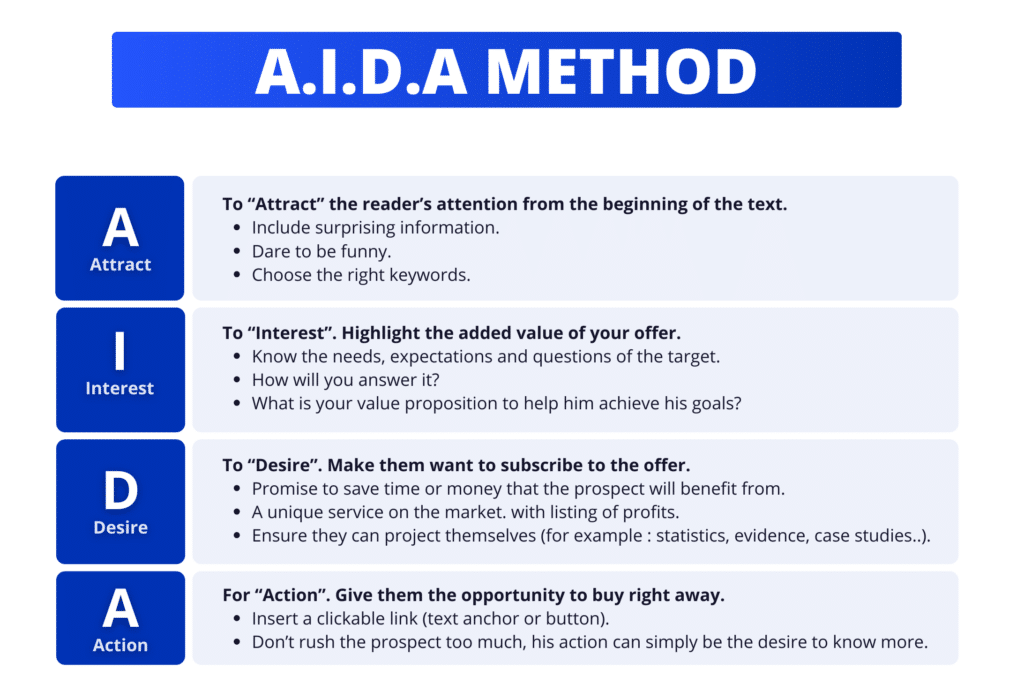
2. The BAB formula (or bridge method 🌉 before/after), which seeks to respond positively to the motivations and impulses of all customers (i.e. pleasure-seeking and/or pain-avoidance) by using incentives in the prospecting email templates :
- “B” for “Before”: to describe the current problem facing your target.
- “A” for “After”: to illustrate the resolution of the problem or the improvement of the situation.
- “B” for Bridge: to show how your solution solves the problem, provides the desired pleasure and improves your prospect’s life.
3. The PAS formula, to establish new relationships and partnerships with your prospects, using negative arguments that drive contacts to react to “avoid the pain” 🤒 :
- “P” for Problem: to focus on a problem that gives your prospect a pain or irritation point.
- “A” is for Agitate: to explain what would happen if the problem continued.
- “S” is for Solution, to give a better way to alleviate/avoid the suffering caused by the situation.
4. The SAS method, to energize a prospecting email template by creating a story around your product using storytelling (very effective B2B cold email with case studies and success stories) 🗣️:
- “S” is for Star, to introduce the star of your story. This could be you, a customer, other companies or individuals.
- “A” is for Arch: to describe the journey of the star, who is – or should be – facing a problem similar to that of your cold lead.
- “S” is for Success: to explain how the star fares, or fares better in the end (referring, of course, to your own product/service).
Next, a few tips and mistakes to avoid in a cold email template B2B.
Prospecting mail: mistakes to avoid
It’s hard to write the perfect cold email template B2B. We’ve already given you some tips on how to really stand out. 🌟
Now we’re giving you the mistakes to avoid in your prospecting email template and cold email template B2B ❌ :
- Too many ideas and CTAs.
- Too long to read (nobody has time for that, take care to email length!).
- Instead of celebrating the consumer, only talk about your company.
- Don’t use personalization.
- Use too much jargon.
- Write as if you were a robot.
- Use an excessive number of emojis and other special characters.
- Make multiple grammatical and spelling errors.
When used incorrectly, emailing causes marketing pressure and can lead to email deliverability problems.
🚨 Here’s a bad prospecting email template :
Subject: 🚀💥 Discover our INCREDIBLE offers!!! 💥🚀
Hello,
At SuperTech, we are WORLD LEADERS in technological innovation. Our REVOLUTIONARY products offer TURNKEY SOLUTIONS for all your business issues. 🎯
Our services include:
👉🏼 Optimization of operational processes: thanks to our state-of-the-art platform, benefit from optimal synergy between your various functional units. 🔄
👉🏼 Increased productivity: our tools enable unprecedented scalability, guaranteeing maximum ROI in record time. 📈
👉🏼 24/7 customer support: our dedicated team is available round-the-clock to ensure impeccable service continuity. 🕛
Don’t wait any longer to propel your business to new horizons! 🌟 Contact us now for a FREE, no-obligation consultation. 📞
Yours sincerely
The SuperTech Solutions team
Take note of these tips, and be sure to add a personal touch to create the right cold email template B2B messages!
From now on, I hope you’ll apply these cold email best practices to your prospecting messages. You’ll thank us later! 😊
How to contact B2B sales prospects easily by email?
To contact your prospects and send cold emails or prospecting emails, you can do it “manually” or use a LinkedIn & Email automation tool (like Waalaxy) to save time! ⏰
👽 Waalaxy is the simplest tool on the market, and its many features will help you to :
- Create and enrich a prospecting database,
- Retrieve and collect your (potential) prospects’ e-mail addresses via LinkedIn.
- Draft, personalize and automatically send your prospecting emails and messages.
The best part is that, unlike LinkedIn messages… There’s no limit to the number of prospecting emails you can send. 🤩
We explain how to make the most of this advantage and contact thousands of prospects through this channel thanks to Waalaxy.
Create a prospecting database
To retrieve/collect e-mail addresses in order to create a database, you can :
- Acquire them “manually”, by asking your prospects directly (possible, but very time-consuming),
- Rent or buy databases (not recommended).
- Email enrichment and automatic data scrapping (highly recommended for the most qualified mailing list possible).
We’ll show you how to create a database with Waalaxy, using this last method. 🔥
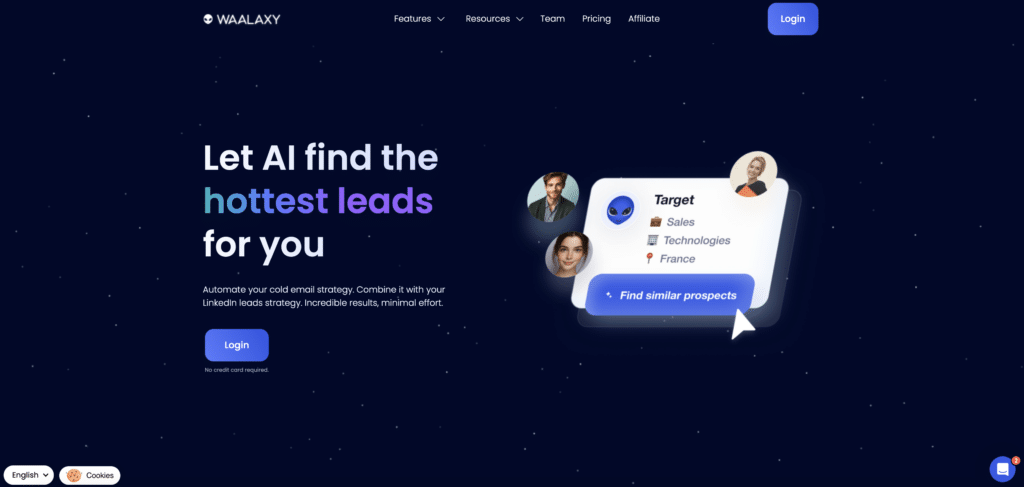
First, use LinkedIn, as it’s the biggest professional network, there is, and you need to make the most of it. 💰
Thanks to the Waalaxy extension (downloadable from Google Chrome), you can automatically retrieve your potential prospects’ data wherever they are, through👇🏼 :
- LinkedIn connections & relationships.
- Groups to which you belong,
- Participants in an event,
- Reactions and comments to a post,
- Or from a LinkedIn standard search (to contact new prospects).
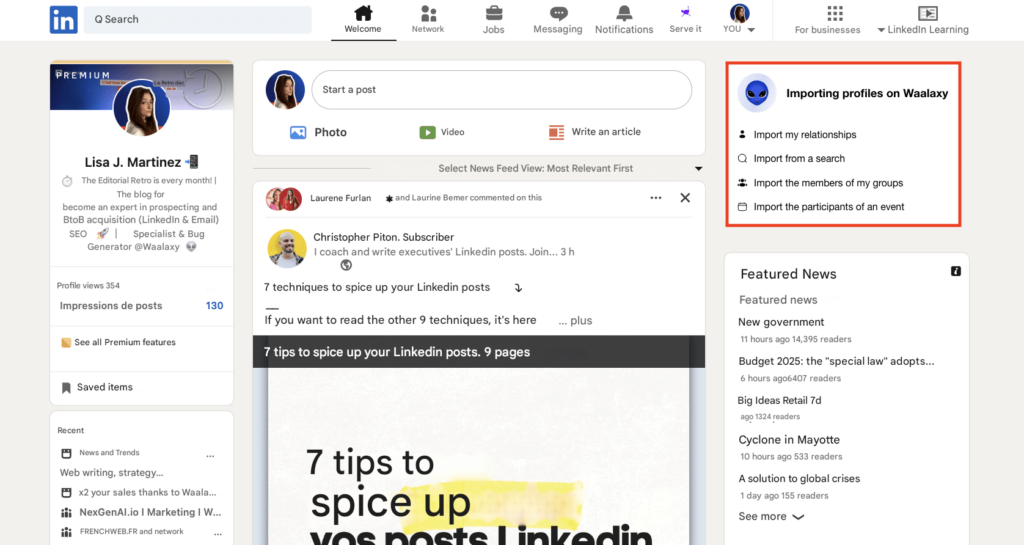
Once the data for the specified number of profiles has been imported (also possible via a .CSV file), you can retrieve your database (or prospect list) directly from the tool. ⚙️
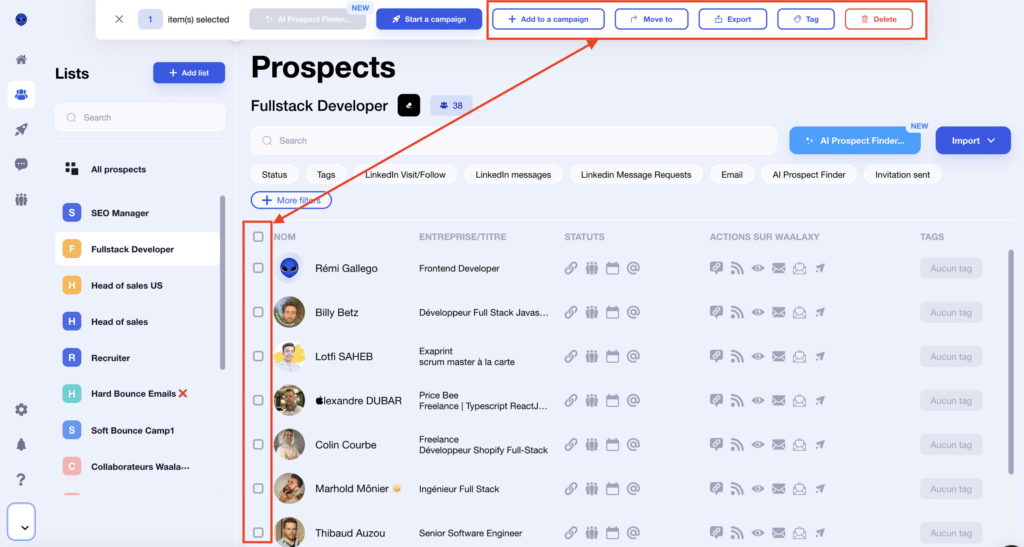
Once you’ve sorted and cleaned it (if necessary), you’re ready to launch your cold email outreach campaign with the Email Finder option, to find the email of all the contacts on your list and automatically send them a prospecting email (perhaps accompanied by several other multichannels B2B prospecting actions). 🎉
Send bulk B2B prospecting email
Click on Start a campaign, then on “Browse sequences”. 📚 You’ll have access to a library with hundreds of ready-to-use automated email and other action sequences.
Choose one of the sequences that contains the Email Finder option 🔍 we recommend you choose the sequence: Email Finder + Email.
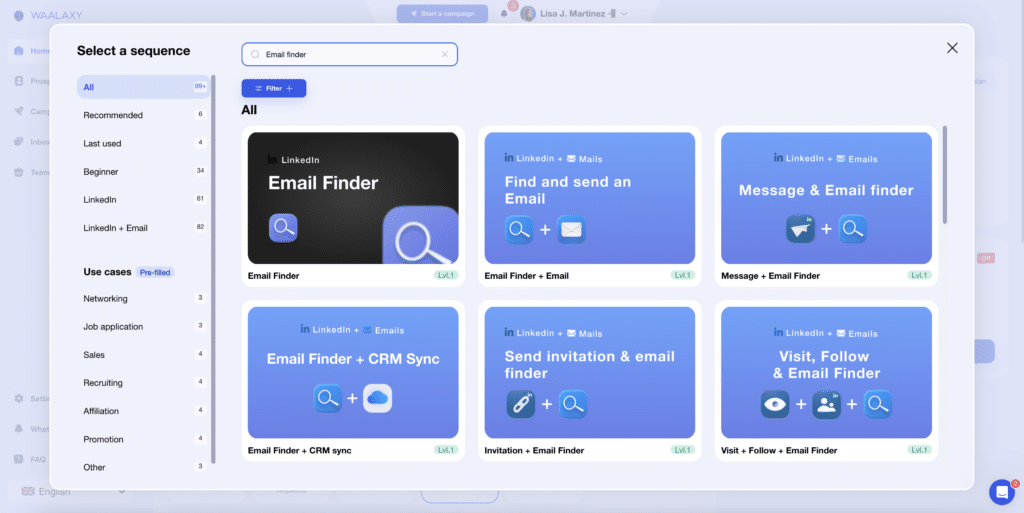
Waalaxy’s Email Finder feature works by credits 🪙 (from 25 to 500 credits/month depending on subscription with purchase of additional credits as needed).
Then, you can write and personalize your prospecting email template directly on Waalaxy (it’s also possible to save a cold email template B2B to reuse in your next ♻️ campaigns).
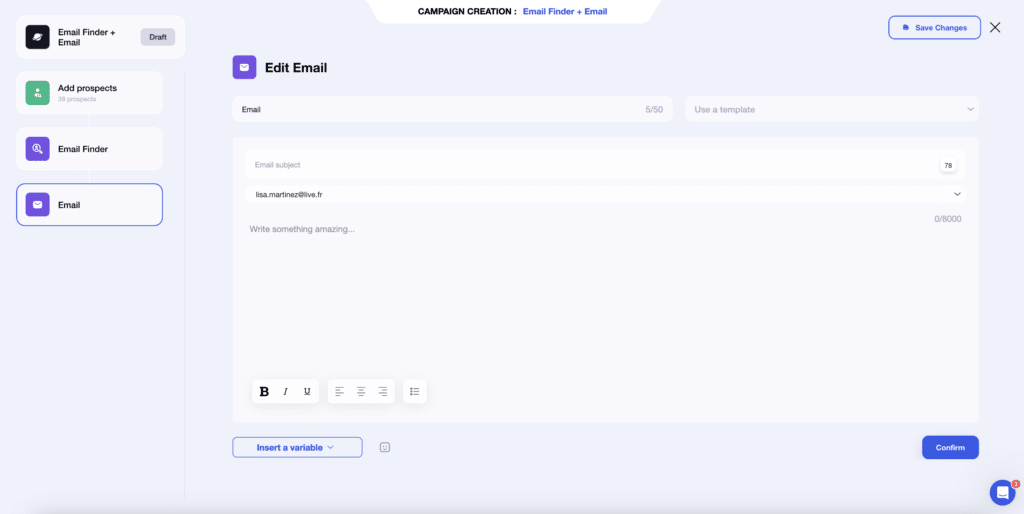
When your prospecting message is ready, click on “Validate” and launch your campaign. 🎉
From then on, you don’t have to do anything except wait for your prospects’ responses in your mailbox and monitor your campaigns’ performance with the Waalaxy sales dashboard. 📊
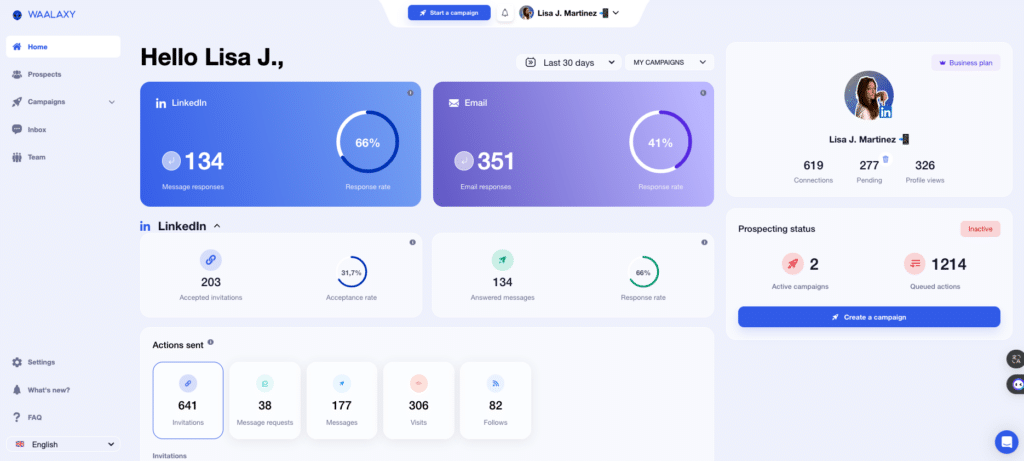
As you can see, Waalaxy works for you and is the perfect tool for sending out a mass email. 🔥
Tips for multichannel prospecting
Waalaxy’s multichannel features are ideal for making numerous contacts with the right people and increasing conversion opportunities.
The more channels you use, the more points of contact you’ll have, and the more likely you’ll get a response! 😉 So we recommend contacting your prospects both by email and on LinkedIn (with Waalaxy Inbox to manage your conversations).
⚠️ But be careful about the frequency of LinkedIn prospecting messages you send, and make sure you give your prospect plenty of breathing space across all channels. You don’t want them to feel harassed, or servers identify email as spam (there’s a fine line between being persistent and being annoying)!
That’s it, now you’ve got no more excuses, you can send kick-ass B2B cold email campaigns right now that will bring you results. 🤩
Conclusion – Best cold email templates B2B
Writing the perfect prospecting email template is not something you can improvise, but it’s essential for optimizing your prospecting campaigns and reaching your objectives! 🏆
By taking inspiration from the +25 best cold email templates B2B and following all the advice given in this article, producing personalized, relevant messages tailored to the specifics of your target and your business will be child’s play. 👶🏻
Finally, sending highly targeted prospecting email template campaigns to a certain group is an effective way of creating new partnerships and finding new customers.
When you combine it with an automation tool like Waalaxy, you have a powerful, almost unstoppable machine! 🤖
Frequently Asked Questions (FAQ)
🏁 To conclude, here are the answers to the most frequently asked questions on the subject. 👇🏼
What’s the difference between a prospecting email and a cold email?
📩 A prospecting email and a cold email refer to two similar types of communication, but with some important differences:
- 🔥 Prospecting email: Sent to prospects who have already shown an interest in your company, products or services. This message aims to deepen a relationship or transform this interest into concrete action (to go on to purchase and become a customer).
- 🧊 Cold sales email template: Sent to totally new contacts, with no prior interaction or interest in your company. The aim is to attract their attention and elicit an initial commitment (for example, by sharing content that might interest them).
In short, the main distinction lies in the degree of initial customer engagement: prospecting emails target contacts who are already engaged, while cold emails are aimed at a still cold audience.
Which catchphrase to use to attract customers?
The catchphrase 🎣 of a prospecting email template must capture attention from the very first seconds, while being clear, relevant and oriented towards the recipient‘s needs. Here are a few examples:
| Use case | Phrase Type | Examples |
|---|---|---|
| Direct question | What if you could reduce [specific problem] by [quantifiable indicator] in just [time]? | What if you could reduce your acquisition costs by 20% in just 2 months? |
| Observation or opportunity | I’ve noticed that [specific company problem] and I think I can help you. | I’ve noticed that your site lacks a clear CTA button on your key pages. With this action, I think I can help you increase your conversion by 15%. |
| Arouse curiosity | We’ve helped [name or industry] with [concrete result] – ready to do the same? | We’ve helped SaaS startups reduce their acquisition costs by 40% – how about you? |
| Invite urgency | What if you could [solve a specific problem] in less [time]? | What if you could double your qualified leads in less than 10 days? Don’t let this opportunity pass you by. |
| Personalize your email | [First name], did you know that [figures/statistics relevant to the company or sector]? | Marie, did you know that 68% of B2B companies lose customers through lack of effective cold email follow-up? |
It’s up to you to use the right catchphrase and adapt it to context of your email! 😉
How can I use LinkedIn to contact prospects?
LinkedIn offers a number of features for getting in touch with your prospects effectively:
- 📩 Invitation requests: Send a connection request or invitation with a personalized, well-written message to establish initial contact as well as increase your chances of being accepted. To find out more, see our articles dedicated to connection message templates and invitation message examples.
- 🌟 InMail (with a Premium account) to contact prospects directly without being connected to them. It’s ideal for longer or personalized cold email template B2B messages.
- 💬 LinkedIn Messages: Once connected, engage in conversation via LinkedIn messages. Be relevant and focus on your interlocutor’s needs (see LinkedIn message examples).
- 🧲 Lead magnet: Distribute e-books, newsletters, events, podcasts through your publications (and also by message).
- Other features: Follow their publications, comment, and interact with their content to establish a more authentic relationship before offering your services.
Use a human, relational and non-intrusive approach in your LinkedIn prospecting to turn prospects into opportunities.
You’re done! 🎬 You know how to write your prospecting message, now you can choose a prospecting email template and use automation to generate results.
You’ve got everything you need to succeed! See you soon. 👽



